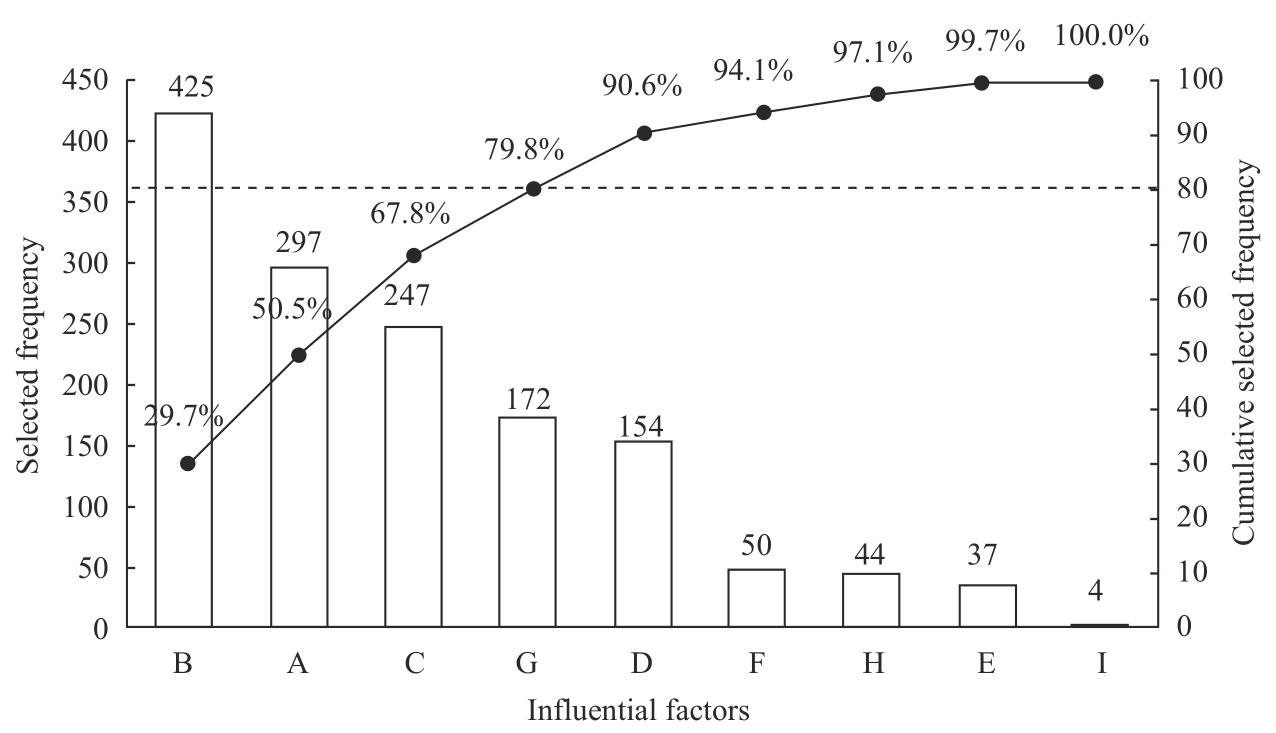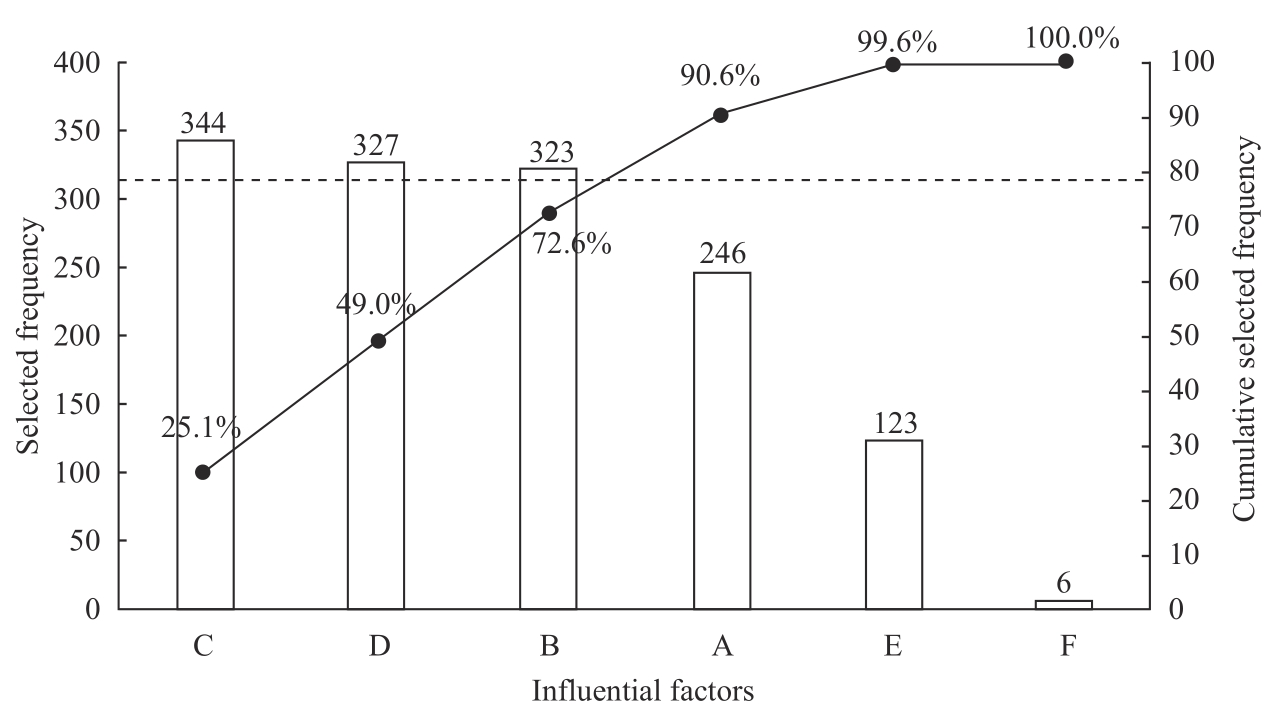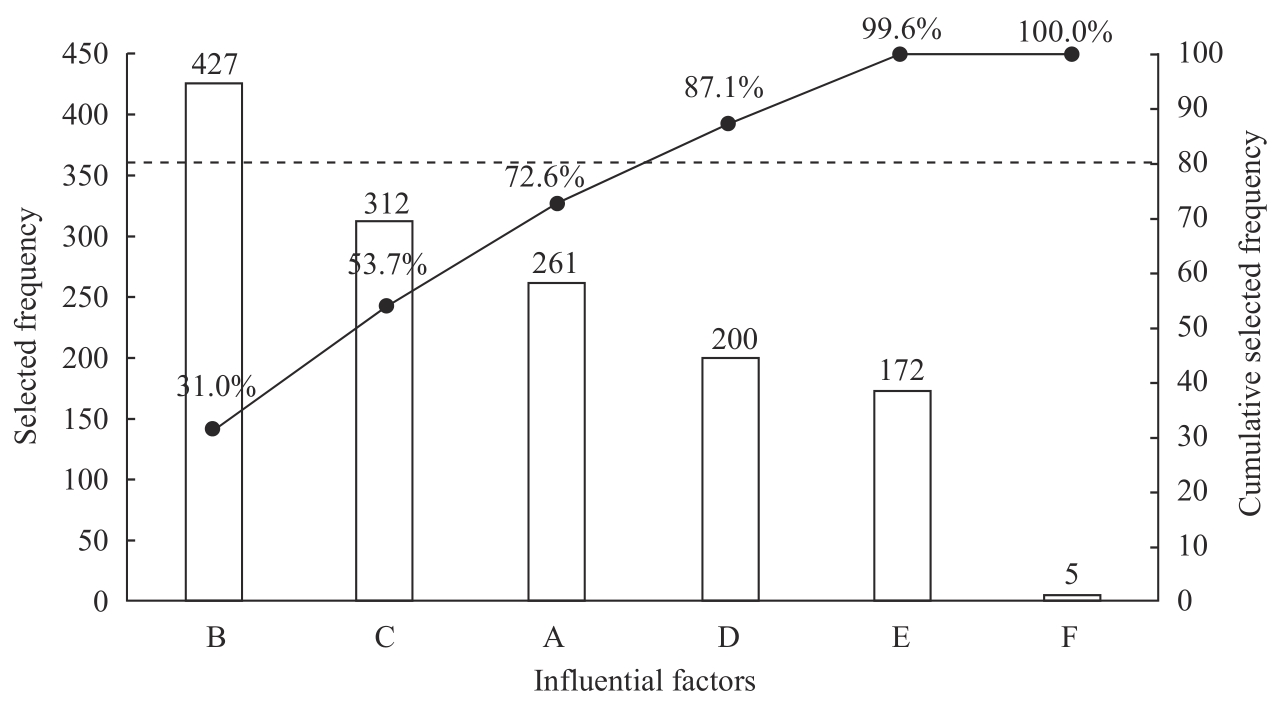
上海交通大学学报(医学版) ›› 2023, Vol. 43 ›› Issue (9): 1211-1218.doi: 10.3969/j.issn.1674-8115.2023.09.016
• 论坛 • 上一篇
李冬凉1( ), 王甦平1, 何豪2, 王炳顺2, 周良3(
), 王甦平1, 何豪2, 王炳顺2, 周良3( )
)
收稿日期:2022-09-01
接受日期:2022-11-16
出版日期:2023-09-28
发布日期:2023-04-24
通讯作者:
周 良,电子信箱:zhouliang@shsmu.edu.cn。作者简介:李冬凉(1976—),女,助理研究员,博士;电子信箱:ldl@sjtu.edu.cn第一联系人:王甦平(1985—),女,副研究员,博士;电子信箱:wangsuping@shsmu.edu.cn
基金资助:
LI Dongliang1( ), WANG Suping1, HE Hao2, WANG Bingshun2, ZHOU Liang3(
), WANG Suping1, HE Hao2, WANG Bingshun2, ZHOU Liang3( )
)
Received:2022-09-01
Accepted:2022-11-16
Online:2023-09-28
Published:2023-04-24
Contact:
ZHOU Liang, E-mail: zhouliang@shsmu.edu.cn.Supported by:摘要:
目的·调研我国临床研究人才队伍建设现况与问题,并提出针对性改进策略。方法·通过文献查阅、专家访谈和2轮德尔菲法自制调查问卷,对来自27个省、市、自治区的医院、生物医药企业、医学院校、政府部门中熟悉临床研究的相关人员(583人)开展网络问卷调研,并对调研结果进行统计分析。结果·共计回收问卷583份,其中有效问卷579份,有效率为99.3%。调研结果显示:① 临床研究人才缺乏和人才发展环境不佳是制约我国高水平临床研究的关键因素。② 在被调查对象中,对当前临床研究人才培养不尽如人意(很不满意、不满意和一般)者占比72.7%。主要问题包括:高水平研究型人才的缺乏,同时缺乏一支专业支撑队伍;目前的绩效评价体系过于单一且薪酬、激励未向临床研究工作倾斜,从事临床研究的医务人员、临床研究支撑服务人才缺乏晋升渠道等。③ 改进策略包括:系统性提升医务人员临床研究能力,完善临床研究能力培训课程体系,在学校教育阶段和在职教育阶段采取不同的培养方式,在临床研究人才队伍的扩充上要注重临床研究型医师和临床研究方法学专门人才两支队伍的培养。结论·提升我国临床研究水平,急需扩大优秀医学生的培养数量,完善临床研究方法学、相关法规等课程;鼓励高水平研究型医师指导新人,在研究项目中做好传帮带;系统化提高在职医务人员的科研能力,做好临床研究项目的规范实施、选题设计等培训;凝聚一支高水平复合型临床研究医务人员队伍,加大临床研究方法学的专业人才培养力度;进一步重视临床研究,从职称晋升、薪酬待遇、科研评价等方面完善临床研究人才的发展环境。
中图分类号:
李冬凉, 王甦平, 何豪, 王炳顺, 周良. 我国临床研究人才队伍建设现况与改进策略研究[J]. 上海交通大学学报(医学版), 2023, 43(9): 1211-1218.
LI Dongliang, WANG Suping, HE Hao, WANG Bingshun, ZHOU Liang. Analysis on the existing problems and improving approaches to the clinical research talents team cultivation in China[J]. Journal of Shanghai Jiao Tong University (Medical Science), 2023, 43(9): 1211-1218.
| Number | Main question |
|---|---|
| 1 | What do you think are the main factors restricting high-level clinical research in China? |
| 2 | Are you satisfied with the current situation of clinical research talent training in China? |
| 3 | What types of talents are the most lacking in the clinical research team at present? |
| 4 | What are the factors restricting the development of clinical research talents in China? |
| 5 | What are the clinical research capabilities that need to be improved for medical personnel? |
| 6 | What specialized courses are most needed to improve the clinical research ability of medical personnel? |
| 7 | To improve the clinical research ability of medical personnel, which training methods are more helpful? |
| 8 | What are the most necessary measures to fill the gap of clinical research methodology talents, clinical research project management specialists, clinical research coordinators and other professionals? |
表1 调查问卷的问题清单
Tab 1 Question list in questionnaire
| Number | Main question |
|---|---|
| 1 | What do you think are the main factors restricting high-level clinical research in China? |
| 2 | Are you satisfied with the current situation of clinical research talent training in China? |
| 3 | What types of talents are the most lacking in the clinical research team at present? |
| 4 | What are the factors restricting the development of clinical research talents in China? |
| 5 | What are the clinical research capabilities that need to be improved for medical personnel? |
| 6 | What specialized courses are most needed to improve the clinical research ability of medical personnel? |
| 7 | To improve the clinical research ability of medical personnel, which training methods are more helpful? |
| 8 | What are the most necessary measures to fill the gap of clinical research methodology talents, clinical research project management specialists, clinical research coordinators and other professionals? |
| Item | Respondent (n=579) |
|---|---|
| Gender | |
| Male | 333 (57.5) |
| Female | 246 (42.5) |
| Education ground | |
| Doctor degree | 114 (19.7) |
| Master degree | 162 (28.0) |
| Bachelor degree | 227 (39.2) |
| Undergraduate | 76 (13.1) |
| Professional title | |
| Senior | 60 (10.4) |
| Deputy senior | 76 (13.1) |
| Medium | 165 (28.5) |
| Primary | 220 (38.0) |
| Under primary | 58 (10.0) |
| Work place | |
| Hospital | 246 (42.5) |
| Grade-A tertiary | 187 (32.3) |
| Non grade-A tertiary | 59 (10.2) |
| Enterprise | 134 (23.1) |
| College and university | 111 (19.2) |
| Government | 47 (8.1) |
| Others | 41 (7.1) |
| Occupation | |
| Physician | 183 (31.6) |
| Nurse | 60 (10.4) |
| Teacher | 86 (14.9) |
| Researcher | 30 (5.2) |
| Administrator | 37 (6.4) |
| Corporation personnel | 137 (23.7) |
| Others | 46 (7.9) |
表2 调查对象的基本情况[n (%)]
Tab 2 Basic information of the respondents [n (%)]
| Item | Respondent (n=579) |
|---|---|
| Gender | |
| Male | 333 (57.5) |
| Female | 246 (42.5) |
| Education ground | |
| Doctor degree | 114 (19.7) |
| Master degree | 162 (28.0) |
| Bachelor degree | 227 (39.2) |
| Undergraduate | 76 (13.1) |
| Professional title | |
| Senior | 60 (10.4) |
| Deputy senior | 76 (13.1) |
| Medium | 165 (28.5) |
| Primary | 220 (38.0) |
| Under primary | 58 (10.0) |
| Work place | |
| Hospital | 246 (42.5) |
| Grade-A tertiary | 187 (32.3) |
| Non grade-A tertiary | 59 (10.2) |
| Enterprise | 134 (23.1) |
| College and university | 111 (19.2) |
| Government | 47 (8.1) |
| Others | 41 (7.1) |
| Occupation | |
| Physician | 183 (31.6) |
| Nurse | 60 (10.4) |
| Teacher | 86 (14.9) |
| Researcher | 30 (5.2) |
| Administrator | 37 (6.4) |
| Corporation personnel | 137 (23.7) |
| Others | 46 (7.9) |

图1 制约我国高水平临床研究的影响因素的帕累托图Note: A. At present, the scientific research evaluation system has led to the establishment of research projects that focus on “less clinical than basic”. B. Generally, the clinical research cycle is too long, and clinical researchers are forced to choose short, easy and fast research topics as far as possible due to the requirements of professional titles, awards, etc. C. Clinical research involves a wide range of areas, lacking initiatives to share collaborative achievements, and build a collaborative research culture. D. Lack of high-level research talents and a professional support team. E. The number of clinical research wards is limited. F. Insufficient investment in clinical research and poor funding channel. G. Medical personnel are busy with their daily diagnosis and treatment, while some types of clinical researches, such as those initiated by researchers, take too much time and they cannot take care of both. H. Lack of channels to understand research frontiers and obtain other internal and external research experience, and limited research ideas. I. Others.
Fig 1 Pareto diagram of influential factors restricting high-level clinical research in China
| Satisfaction | Respondents (n=579)/n (%) | Hospital staff (n=246)/n (%) | Non-hospital staff (n=333)/n (%) | |
|---|---|---|---|---|
Grade-A tertiary hospital (n=187) | Non grade-A tertiary hospital (n=59) | |||
| Very dissatisfied | 77 (13.2) | 14 (7.5) | 4 (6.8) | 59 (17.7) |
| Dissatisfied | 137 (23.7) | 27 (14.4) | 17 (28.8) | 93 (27.9) |
| Average | 207 (35.8) | 69 (36.9) | 18 (30.5) | 120 (36.0) |
| Satisfactory | 142 (24.5) | 69 (36.9) | 19 (32.2) | 54 (16.2) |
| Very satisfied | 16 (2.8) | 8 (4.3) | 1 (1.7) | 7 (2.1) |
表3 调查对象对我国临床研究人才培养现状的满意度评价
Tab 3 Satisfaction evaluation of respondents on the current clinical research talent cultivation in China
| Satisfaction | Respondents (n=579)/n (%) | Hospital staff (n=246)/n (%) | Non-hospital staff (n=333)/n (%) | |
|---|---|---|---|---|
Grade-A tertiary hospital (n=187) | Non grade-A tertiary hospital (n=59) | |||
| Very dissatisfied | 77 (13.2) | 14 (7.5) | 4 (6.8) | 59 (17.7) |
| Dissatisfied | 137 (23.7) | 27 (14.4) | 17 (28.8) | 93 (27.9) |
| Average | 207 (35.8) | 69 (36.9) | 18 (30.5) | 120 (36.0) |
| Satisfactory | 142 (24.5) | 69 (36.9) | 19 (32.2) | 54 (16.2) |
| Very satisfied | 16 (2.8) | 8 (4.3) | 1 (1.7) | 7 (2.1) |
| Lack of talent type | No.1/n | No.2/n | No.3/n | No.4/n | No.5/n | No.6/n | Ranking average score/score | Final ranking |
|---|---|---|---|---|---|---|---|---|
| Research physician | 277 | 50 | 40 | 28 | 21 | 1 | 5.3 | 1 |
| Clinical research methodology talent (such as statistician) | 115 | 151 | 75 | 31 | 17 | 0 | 4.8 | 2 |
| Full time scientific researcher | 99 | 93 | 53 | 41 | 70 | 1 | 4.3 | 3 |
| Research nurse | 1 | 2 | 3 | 4 | 5 | 0 | 3.3 | 4 |
| Project management coordinator | 1 | 2 | 3 | 4 | 5 | 6 | 2.7 | 5 |
| Others | 1 | 2 | 0 | 4 | 5 | 6 | 2.4 | 6 |
表4 调查对象对临床研究人才类型的缺乏程度的评价统计
Tab 4 Statistics of respondents′ evaluation on the lack of clinical research talent type
| Lack of talent type | No.1/n | No.2/n | No.3/n | No.4/n | No.5/n | No.6/n | Ranking average score/score | Final ranking |
|---|---|---|---|---|---|---|---|---|
| Research physician | 277 | 50 | 40 | 28 | 21 | 1 | 5.3 | 1 |
| Clinical research methodology talent (such as statistician) | 115 | 151 | 75 | 31 | 17 | 0 | 4.8 | 2 |
| Full time scientific researcher | 99 | 93 | 53 | 41 | 70 | 1 | 4.3 | 3 |
| Research nurse | 1 | 2 | 3 | 4 | 5 | 0 | 3.3 | 4 |
| Project management coordinator | 1 | 2 | 3 | 4 | 5 | 6 | 2.7 | 5 |
| Others | 1 | 2 | 0 | 4 | 5 | 6 | 2.4 | 6 |

图2 制约临床研究人才建设的影响因素的帕累托图Note: A. Managers have insufficient understanding of the importance of clinical research. B. There is a shortage of clinical research talents, and the current personnel are lack of clinical research ability. C. The current performance evaluation system is monotonous, meanwhile the salary and incentive are not profit able for clinical research. D. In the existing evaluation and employment system, there is no clinical research professional title, and medical personnel engaged in clinical research and support staff lack promotion channels. E. The lack of research culture of collaboration and sharing makes it difficult to form a strong clinical research cooperation team. F. Others.
Fig 2 Pareto diagram of influential factors restricting the construction of clinical research talents

图3 临床研究人员亟需提升的核心能力的帕累托图Note:A. Finding clinical problems and refining research direction. B. Clinical study design. C. Standardizing clinical research, including quality control and data collection. D. Statistical analysis and other clinical research methods. E. Knowing relevant laws and regulations. F. Communication, coordination, organization and management during project implementation. G. Others.
Fig 3 Pareto diagram of core competences that clinical researchers need to improve

图4 临床研究人员能力培训的课程体系建设的帕累托图Note: A. Core knowledge and new progress of clinical specialty (including theory and operation). B. Clinical research methodology course (including research design, epidemiology and statistics). C. Laws and regulations related to clinical research (such as ethical norms, regulatory policies, etc.). D. Advanced medical theories and technologies. E. Interpretation of actual cases in clinical research. F. Others.
Fig 4 Pareto diagram of curriculum system construction for competence training of clinical researchers
| Item | Respondents (n=579)/n (%) | Ranking |
|---|---|---|
| Adding clinical research-related courses in the school training stage of doctors and nurses | 323 (55.8) | 1 |
| Guiding new people and helping them in teams by tutors with clinical research experience | 287 (49.6) | 2 |
| Carrying out short-term on-the-job training and teaching with cases | 279 (48.2) | 3 |
| Participating in high-level and standardized clinical research projects | 208 (35.9) | 4 |
| Conducting expert forums to promote peer exchanges | 180 (31.1) | 5 |
| Joint training with enterprises with clinical research experience, and short-term exchange of talents | 148 (25.6) | 6 |
| Others | 2 (0.3) | 7 |
表5 临床研究人才培养方式的选择及统计
Tab 5 Selection and statistics of the training methods for clinical research talents
| Item | Respondents (n=579)/n (%) | Ranking |
|---|---|---|
| Adding clinical research-related courses in the school training stage of doctors and nurses | 323 (55.8) | 1 |
| Guiding new people and helping them in teams by tutors with clinical research experience | 287 (49.6) | 2 |
| Carrying out short-term on-the-job training and teaching with cases | 279 (48.2) | 3 |
| Participating in high-level and standardized clinical research projects | 208 (35.9) | 4 |
| Conducting expert forums to promote peer exchanges | 180 (31.1) | 5 |
| Joint training with enterprises with clinical research experience, and short-term exchange of talents | 148 (25.6) | 6 |
| Others | 2 (0.3) | 7 |

图5 临床研究人才队伍扩充关键途径的帕累托图Note: A. Recruiting clinical research practitioners with relevant qualifications from the society, and carrying short-term training. B. Increasing clinical research courses in the training of medical statistics, preventive medicine, clinical nursing, medical laboratory and other related majors. C. Increasing the enrollment of clinical research methodology, and cultivating clinical research professionals. D. Setting clinical research degree points to attract and cultivate graduate level clinical research methodology talents. E. Setting special clinical research posts, improving the professional title evaluation and employment scheme, and improving the career stability of clinical researchers. F. Others.
Fig 5 Pareto diagram of key approaches to expand clinical research talents
| 1 | 曹烨. 哈佛医学院DF/HCC临床研究管理介绍: 临床研究的“中心化”管理[J]. 中国新药杂志, 2015, 24(18): 2128-2133. |
| CAO Y. Introduction of Harvard Medical School DF/HCC clinical research management: “centralized” management of clinical research[J]. Chin New Drug J, 2015, 24(18): 2128-2133. | |
| 2 | TERESKERZ P M, EDELMAN R,MCKINNEY R. Clinical research and the law[M]. Oxford Hoboken: Wiley-Blackwell Publishing, 2012. |
| 3 | PAGE P, CARR J, EARDLEY W, et al. An introduction to clinical research[M]. New York: Oxford University Press, 2012. |
| 4 | 杨佳, 张晓方. 关于高校新兴学科建设的实践与思考[J]. 中国校外教育, 2016(16): 21, 142. |
| YANG J, ZHANG X F. Practice and reflection on the construction of new disciplines in colleges and universities[J]. Education for Chinese After-school, 2016(16): 21, 142. | |
| 5 | 改善中国临床研究监管体系的几点建议[J]. 中国新药杂志, 2018, 27(11): 1217-1224. |
| Several suggestions on improving China′s clinical research regulatory system[J]. Chin New Drug J, 2018, 27(11): 1217-1224. | |
| 6 | 王吉耀. 我国临床研究的现状和展望[J]. 中华医学杂志, 2010, 90(38): 2665-2666. |
| WANG J Y. Current situation and prospect of clinical research in China[J]. Chin Med J, 2010, 90(38): 2665-2666. | |
| 7 | 洪志恒, 王苹, 曹卫华. 慢性病观察性研究论文统计学应用评价[J]. 中华流行病学杂志, 2012, 33(9): 964-968. |
| HONG Z H, WANG P, CAO W H. Evaluation of statistical application of observational research papers on chronic diseases[J]. Chin J Epidemiol, 2012, 33(9): 964-968. | |
| 8 | 孔媛媛, 曾娜, 魏巍, 等. 临床医学专业学位研究生临床研究方法学教学模式创新与实践[J]. 继续医学教育, 2017, 31(5): 29-31. |
| KONG Y Y, ZENG N, Wei W, et al. Innovation and practice of teaching mode of clinical research methodology for postgraduates of clinical medicine[J]. China Continuing Medical Education, 2017, 31(5): 29-31. | |
| 9 | 郝国祥, 郑义, 吴月娥, 等. 医教协同培养儿童药物临床研究人才的探索与实践[J]. 中国现代应用药学, 2022, 39(12): 1526-1531. |
| HAO G X, ZHENG Y, WU Y E, et al. Exploration and practice of training clinical research talents of children′s drugs in combination with medicine and education[J]. Chin J Modern Appl Pharm, 2022, 39(12): 1526-1531. | |
| 10 | 赵生美, 梁少宇, 陈蕾. 新医科背景下临床研究通识教育课程体系构建[J]. 医学教育研究与实践, 2021, 29(2): 203-206. |
| ZHAO S M, LIANG S Y, CHEN L. Construction of general education curriculum system of clinical research under the new medical background[J]. Medical Education Research and Practice, 2021, 29(2): 203-206. | |
| 11 | 崔传霞. 三甲综合医院医疗核心人才综合评级指标体系构建研究[D]. 青岛: 青岛大学, 2018. |
| CUI C X. Research on the construction of the comprehensive rating index system for medical core talents in the third class general hospital[D]. Qingdao: Qingdao University, 2018. | |
| 12 | 雷翔, 王晓晖, 李静, 等. 中国临床试验CRO的发展与变革[J]. 中国循证医学杂志, 2018, 18(8): 783-786. |
| LEI X, WANG X H, LI J, et al. Development and reform of CRO in clinical trials in China[J]. Chinese Journal of Evidence Based Medicine, 2018, 18(8): 783-786. | |
| 13 | 饶守春. A股再添CRO巨头康龙化成上市或引行业局变[N]. 21世纪经济报道, 2018-11-07(14). |
| RAO S C. The listing of Kanglong Huacheng, another CRO giant added to A-shares, may lead to changes in the industry[N]. 21st Century Business Herald, 2018-11-07(14). | |
| 14 | 中国临床研究体系设计与实施的顶层设计思考[J]. 中国新药杂志, 2018, 27(11): 1209-1216. |
| Top level design thinking on the design and implementation of China′s clinical research system[J]. Chin New Drug J, 2018, 27(11): 1209-1216. |
| [1] | 康力, 王未, 冯铁男, 崔婷婷, 王甦平. 医学院校临床研究水平提升的策略探讨[J]. 上海交通大学学报(医学版), 2024, 44(9): 1197-1204. |
| [2] | 荣雯雯1,汪 刚1,朱其立2. 基于人工智能的病历后结构化专病数据库在临床研究中的价值探讨[J]. 上海交通大学学报(医学版), 2020, 40(7): 995-1000. |
| [3] | 渠田田1, 2*,冯铁男1, 2*,姜嘉媛1, 2,张 帆1, 2,钱碧云1, 2. 全球新型冠状病毒肺炎临床研究注册信息的分析与思考[J]. 上海交通大学学报(医学版), 2020, 40(6): 707-712. |
| [4] | 史文涛1,吴思成1,崔东琦1,陈凌燕1,陈世杰1,王步轶1,林晓涵1,张 靓1,瞿轶慧1,许 锋2#,吴 皓3, 4#. 研究者发起的干预性临床研究质量评价体系的构建[J]. 上海交通大学学报(医学版), 2020, 40(10): 1430-1436. |
| [5] | 张志愿. 口腔颌面表型组计划——口腔医学可持续发展的新起点[J]. 上海交通大学学报(医学版), 2020, 40(10): 1321-1323. |
| [6] | 朱丽君,程莎妮,王浩,杜业业,潘玩荣,徐小靖,刘慧俊,周善晟,诸海英,牟姗,朱建征. 研究型医院构建过程中临床专职科研队伍建设的思考[J]. 上海交通大学学报(医学版), 2017, 37(6): 715-. |
| [7] | 周立彻,刘军. 眼球运动在帕金森病中的研究进展[J]. 上海交通大学学报(医学版), 2016, 36(9): 1399-. |
| [8] | 曹惠敏 薛晓梅 尤纱纱 何斌. miRNA在急性冠脉综合征中的临床研究进展[J]. 上海交通大学学报(医学版), 2016, 36(8): 1215-. |
| [9] | 许 迅. 重视和规范眼科临床研究和临床与基础相结合的研究[J]. , 2012, 32(2): 131-. |
| [10] | 王 莹, 蔡 威. 橄榄油脂肪乳剂的研究进展[J]. , 2012, 32(1): 107-. |
| [11] | 蔡 威. 我国营养学发展现状[J]. , 2010, 30(1): 1-. |
| 阅读次数 | ||||||
|
全文 |
|
|||||
|
摘要 |
|
|||||